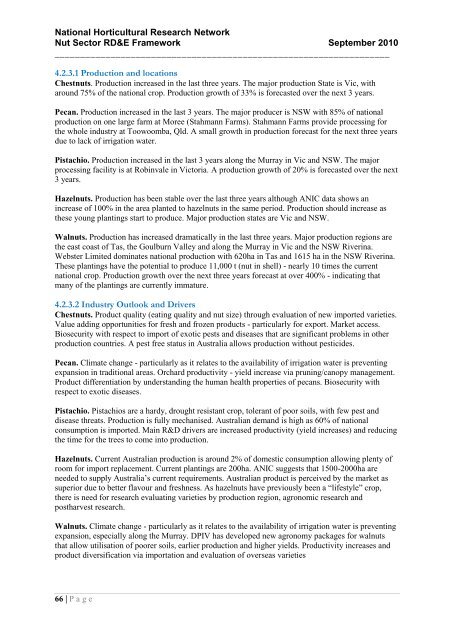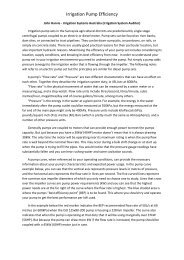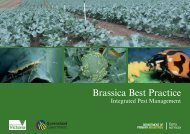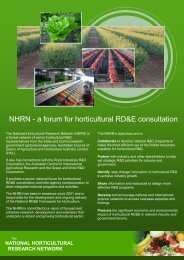National Horticultural Research Network - Horticulture Industry ...
National Horticultural Research Network - Horticulture Industry ...
National Horticultural Research Network - Horticulture Industry ...
Create successful ePaper yourself
Turn your PDF publications into a flip-book with our unique Google optimized e-Paper software.
<strong>National</strong> <strong>Horticultural</strong> <strong>Research</strong> <strong>Network</strong><br />
Nut Sector RD&E Framework September 2010<br />
__________________________________________________________________<br />
4.2.3.1 Production and locations<br />
Chestnuts. Production increased in the last three years. The major production State is Vic, with<br />
around 75% of the national crop. Production growth of 33% is forecasted over the next 3 years.<br />
Pecan. Production increased in the last 3 years. The major producer is NSW with 85% of national<br />
production on one large farm at Moree (Stahmann Farms). Stahmann Farms provide processing for<br />
the whole industry at Toowoomba, Qld. A small growth in production forecast for the next three years<br />
due to lack of irrigation water.<br />
Pistachio. Production increased in the last 3 years along the Murray in Vic and NSW. The major<br />
processing facility is at Robinvale in Victoria. A production growth of 20% is forecasted over the next<br />
3 years.<br />
Hazelnuts. Production has been stable over the last three years although ANIC data shows an<br />
increase of 100% in the area planted to hazelnuts in the same period. Production should increase as<br />
these young plantings start to produce. Major production states are Vic and NSW.<br />
Walnuts. Production has increased dramatically in the last three years. Major production regions are<br />
the east coast of Tas, the Goulburn Valley and along the Murray in Vic and the NSW Riverina.<br />
Webster Limited dominates national production with 620ha in Tas and 1615 ha in the NSW Riverina.<br />
These plantings have the potential to produce 11,000 t (nut in shell) - nearly 10 times the current<br />
national crop. Production growth over the next three years forecast at over 400% - indicating that<br />
many of the plantings are currently immature.<br />
4.2.3.2 <strong>Industry</strong> Outlook and Drivers<br />
Chestnuts. Product quality (eating quality and nut size) through evaluation of new imported varieties.<br />
Value adding opportunities for fresh and frozen products - particularly for export. Market access.<br />
Biosecurity with respect to import of exotic pests and diseases that are significant problems in other<br />
production countries. A pest free status in Australia allows production without pesticides.<br />
Pecan. Climate change - particularly as it relates to the availability of irrigation water is preventing<br />
expansion in traditional areas. Orchard productivity - yield increase via pruning/canopy management.<br />
Product differentiation by understanding the human health properties of pecans. Biosecurity with<br />
respect to exotic diseases.<br />
Pistachio. Pistachios are a hardy, drought resistant crop, tolerant of poor soils, with few pest and<br />
disease threats. Production is fully mechanised. Australian demand is high as 60% of national<br />
consumption is imported. Main R&D drivers are increased productivity (yield increases) and reducing<br />
the time for the trees to come into production.<br />
Hazelnuts. Current Australian production is around 2% of domestic consumption allowing plenty of<br />
room for import replacement. Current plantings are 200ha. ANIC suggests that 1500-2000ha are<br />
needed to supply Australia‟s current requirements. Australian product is perceived by the market as<br />
superior due to better flavour and freshness. As hazelnuts have previously been a “lifestyle” crop,<br />
there is need for research evaluating varieties by production region, agronomic research and<br />
postharvest research.<br />
Walnuts. Climate change - particularly as it relates to the availability of irrigation water is preventing<br />
expansion, especially along the Murray. DPIV has developed new agronomy packages for walnuts<br />
that allow utilisation of poorer soils, earlier production and higher yields. Productivity increases and<br />
product diversification via importation and evaluation of overseas varieties<br />
66 | P a g e






